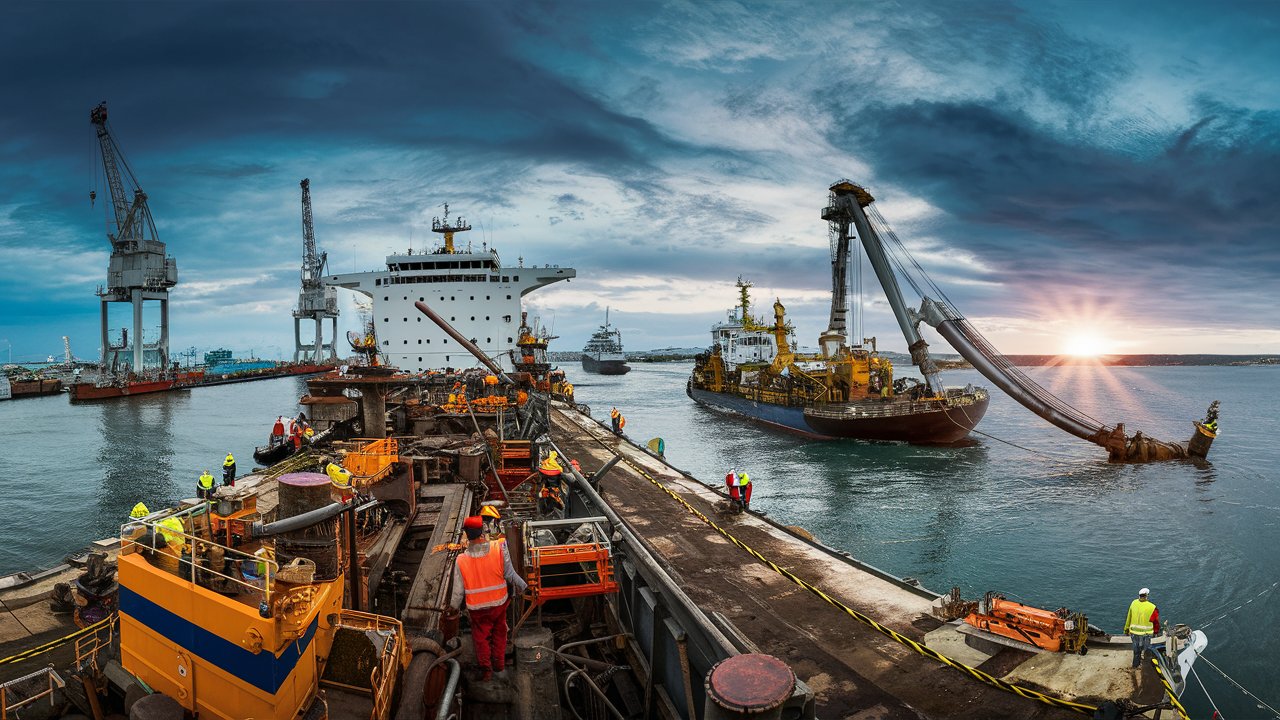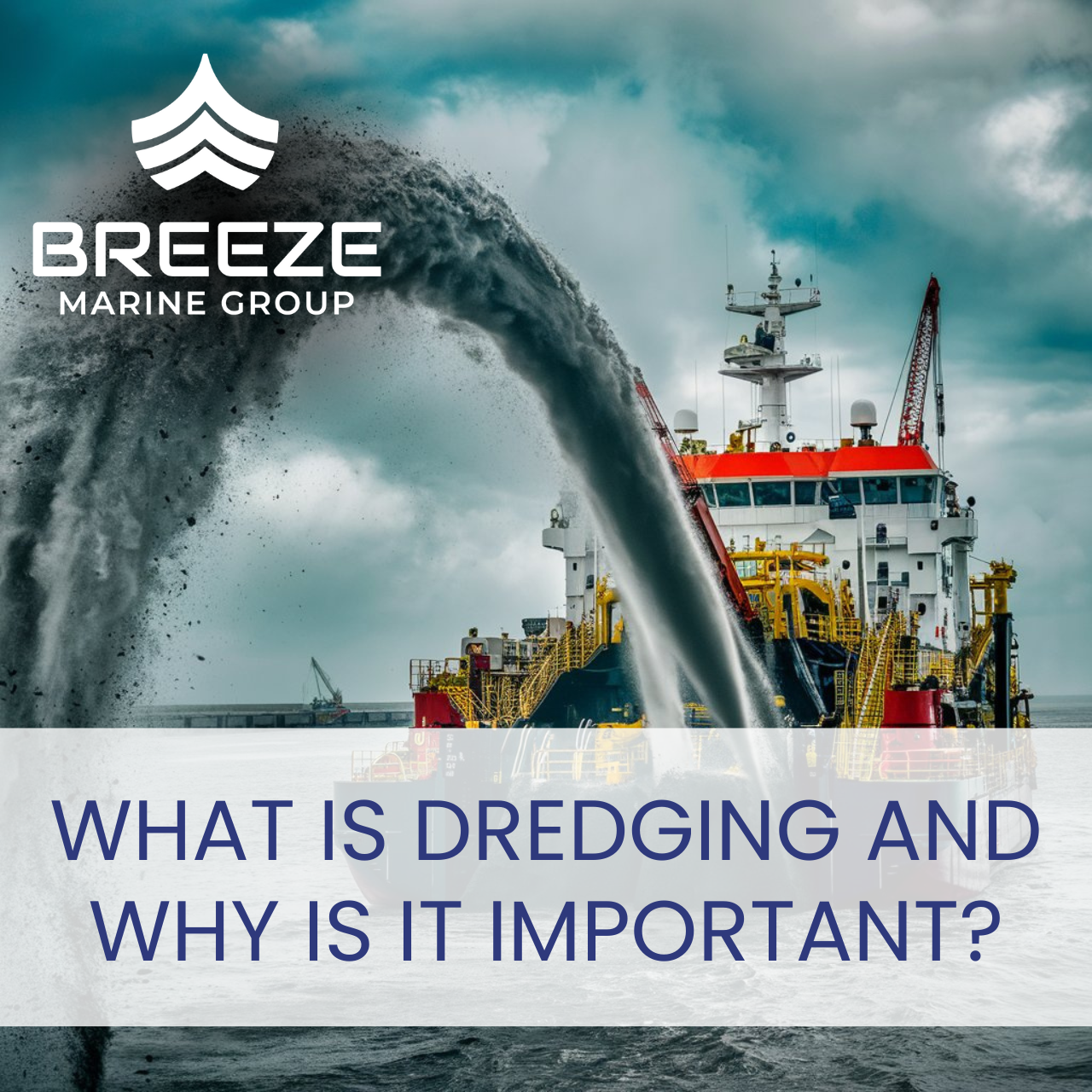Definition and Overview
Dredging is the process of removing and excavating sediments, debris, and other materials below water bodies like rivers, harbors, and coastal areas. This essential procedure helps maintain and deepen navigable waterways, facilitating safe and efficient marine transportation.
There are various types of dredging equipment and methods that help achieve the goals of dredging. One of the most common and widely used are cutter suction dredgers, equipped with a rotating cutter head to loosen material, which is then sucked up and transported through pipelines.
There are also trailing suction hopper dredgers that operate by dragging a suction pipe along the seabed, collecting sediments into a hopper for transport to disposal sites.
Other specialized dredging machinery include bucket dredgers and grab dredgers that are useful for more precise or challenging conditions.
Each method and equipment type is chosen based on the specific requirements of the dredging project, ensuring the highest level of efficiency and effectiveness.
Importance and Applications

Water Depth and Navigability
Dredging is essential for maintaining the required water depth in harbors, channels, rivers, and canals. Accumulated sediments and debris can obstruct these waterways, posing significant risks to the passage of vessels.
However, removing these obstructions ensures that marine pathways remain clear and safe, preventing accidents and delays. Dredging is particularly important for busy ports and waterways where traffic is high and consistent water depth is necessary for smooth operations.
Enabling the Passage of Larger Ships
The global maritime industry relies on the efficient movement of goods, and larger ships are increasingly used to transport bulk cargo.
Dredging plays a vital role in accommodating these vessels by deepening and widening shipping channels and harbor basins. This allows ports to handle larger ships, enhancing their capacity and competitiveness.
Consequently, dredging facilitates maritime trade and transportation, driving economic growth and development in port cities and regions.
Coastal Management and Flood Control
Dredging also helps in coastal management and flood control. Through excess sediment removal and restoring natural water flow, it helps mitigate the risk of flooding in vulnerable coastal and riverine areas.
Additionally, dredging is used in beach nourishment projects, where sand is redistributed to eroding shorelines to protect coastal infrastructure and habitats.
Environmental Remediation
Environmental remediation is another vital application of dredging. Contaminated sediments in bodies of water can pose severe environmental and health risks.
However, dredging removes these hazardous materials, helping to restore and preserve aquatic ecosystems. This process, in turn, supports the rehabilitation of polluted waterways, contributing to a healthier and more sustainable environment.
Land Reclamation
Dredging is pivotal in land reclamation projects, where new land is created from oceans, rivers, or lakes.
Engineers can develop new land areas for various purposes, such as expanding urban spaces, creating agricultural fields, or developing new industrial zones by relocating sediment, sand, and soil.
This practice is especially valuable in regions where land scarcity is an issue, providing a sustainable solution for accommodating growing populations and economic activities.
Habitat Restoration
Dredging also helps in habitat restoration efforts, particularly in wetlands and marshes.
Ecosystems are often threatened by sedimentation, pollution, and human activities. But through targeted dredging, sediments can be removed or redistributed to restore natural habitats, improve water quality, and enhance biodiversity.
Additionally, projects like estuaries, lakes, and riverbanks restoration benefit from dredging by reestablishing native plant and animal species, contributing to the overall health of the ecosystem.
Infrastructure Development
Another application of dredging is in various infrastructure development projects, such as constructing bridges, tunnels, and underwater pipelines.
When building strong foundations, removing the sediments in the ground is important to create stability.
Even in maintaining and upgrading existing infrastructure, dredging helps ensure longevity and functionality. For instance, dredging around bridge piers and abutments can prevent sediment buildup that might compromise structural integrity.
Environmental Considerations and Impacts
While dredging is essential for various maritime and infrastructure purposes, it can have significant environmental impacts.
One of the primary concerns is the disturbance of aquatic ecosystems. The process of dredging can disrupt habitats, displace marine life, and disturb sediment layers that are home to various organisms, causing loss of biodiversity and negatively affecting the health of aquatic environments.
Water quality is another major issue. Dredging can stir up sediments, releasing pollutants and toxins trapped in the seabed into the water column. The effect is usually increased turbidity, which affects light penetration and harms photosynthetic aquatic plants. Moreover, the resuspension of pollutants can pose risks to both marine life and human health, particularly in areas used for fishing and recreation.
Mitigation Strategies and Best Practices
To mitigate these environmental effects, several strategies and best practices are employed in dredging projects.
First, environmental impact assessments are conducted before the start of dredging activities to understand the potential impacts and develop mitigation plans.
Also, careful selection of dredging methods and equipment helps reduce the extent of habitat disruption and sediment resuspension. For instance, using silt screens can help contain sediment plumes and protect sensitive areas.
Furthermore, monitoring water quality throughout the dredging process ensures that any adverse effects are detected early and addressed promptly.
Consequently, sustainable disposal practices, such as using dredged material for beneficial purposes like land reclamation or habitat restoration, can turn a potential environmental liability into an asset.
Conclusion
Dredging is a vital process in the maritime industry, essential for maintaining navigable waterways, supporting maritime trade, and managing coastal environments. While it offers significant benefits, such as land reclamation and habitat restoration, it also poses environmental challenges.
However, careful planning, choosing appropriate methods, and implementing best practices can minimize the negative impacts of dredging on aquatic ecosystems.
Understanding the importance of dredging helps marine engineers, vessel managers, and captains optimize their operations while safeguarding the environment.
Lastly, as we advance, balancing the benefits and impacts that dredging offers will remain crucial for sustainable maritime development.
